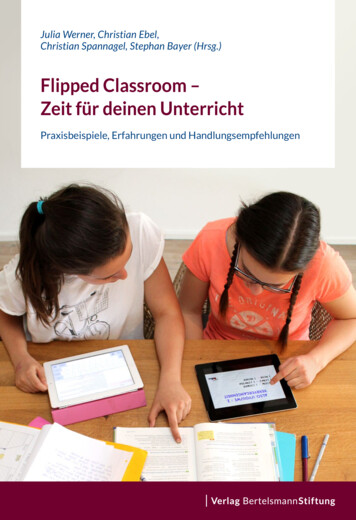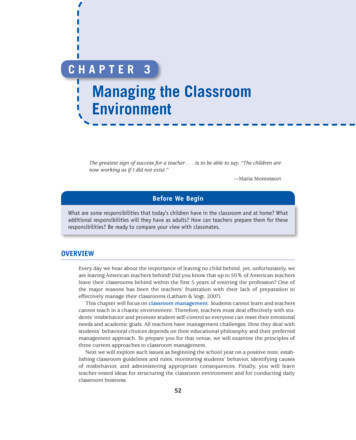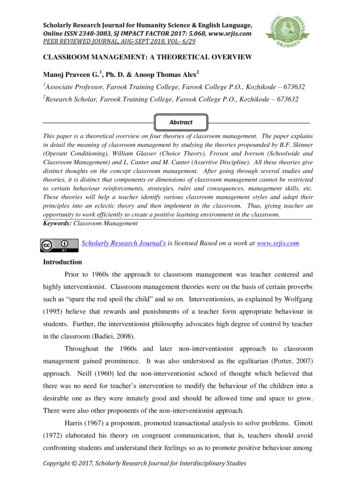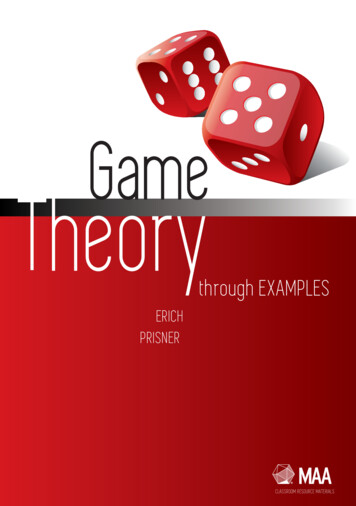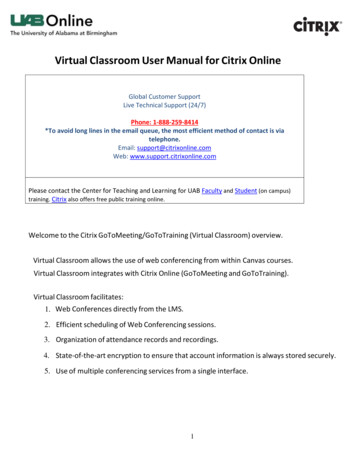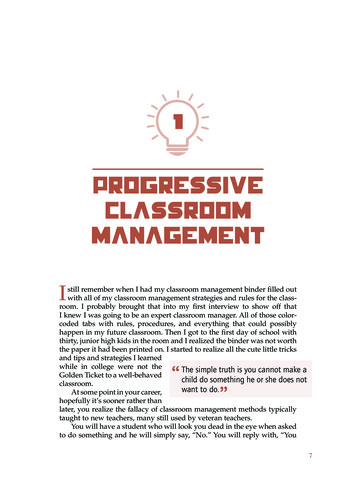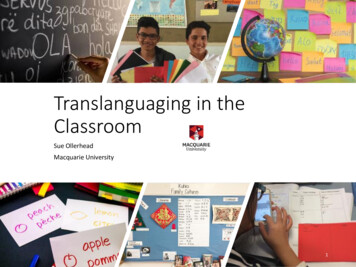
Transcription
Translanguaging in theClassroomSue OllerheadMacquarie University1
Workshop overviewPart 1: Understanding the multilingual nature ofNSW schoolsPart 2: The role of the home language inchildren’s learning: what does the research say?Part 3: What is translanguaging and how can weuse it in the classroom?2
PART 1:THE MULTILINGUALNATURE OF NSWSCHOOLSCultural and linguistic diversityDifferentiation3
Culturally and linguistically diverselearners in NSW35.9%64.1%English speaking onlyLanguages other than EnglishSource: CESE, 20194
Culturally and linguistically diverse learners in NSWSource: CESE, 20195
Culturally and linguistically diverse learners in NSWSource: CESE, 20196
Mainstreaming of EAL/D studentsImplications for differentiation? It is better to set the same high expectations for all students and to providedifferentiated levels of support to ensure that all students have a fairchance to achieve those expectations (p. 8). All mainstream teachers should be able to accommodate EAL/D students. Teachers should actively invite EAL/D students to share their cultural andlinguistic knowledge and experiences.ACARA, 2014: English as an additional language overview and advice
PART 2: THE ROLEOF THE HOMELANGUAGE INCHILDREN’SSCHOOLLEARNING8
The development of the second languageis strongly related to the development ofthe first language Some parents stop using their home language with theirchildren, to help them learn the school language more quickly. However, there is a relationship between first/dominantlanguage development and learning a new language at school(Genesee, 2012). Language practices only emerge in interrelationship with oldlanguage practices. i.e. from the “known” to the “unknown”.Implication 1: Parents, teachers and schools should pay carefulattention to the continued development of the home language tosupport L2 learningStrong L1developmentIncomplete L1development9
Academic outcomes are greater whenboth languages are developed throughschool As well as aiding language development, the homelanguage also promotes academic progress. Trying tolearn a new language while trying to learn poses a doublechallenge. Children who are doing both are learning veryhard! Allowing or requiring students to manage academiccontent in their dominant language ensures that learninghappens even when their English is still in development.Implication 2: Learning should not be put on hold whilelanguage acquisition is happening10
Children adapt and learn betterwhen their own languages arepresent in the classroom Children are not all “little sponges” who do not mindbeing dropped into an environment where they can’tuse their own language. Children are expected to getused to a new environment, make friends and learn,all while learning a new language! If we want children to be ‘ready to learn’, we need tohelp them feel safe and connected in their newenvironment. For children who do not yet speak the schoollanguage, this means putting in place structures andsystems that allow children to connect with theirteachers and their peers while they acquire English.11
The affective filter In SLA theory the “affective filter” is a mental barrier thatlearners build when they feel insecure in the classroom. Theless they can communicate, the higher they build theirprotective wall, which can inhibits learning. Students who are able to use all of their linguistic resourcesfor learning are more likely to be engaged in learning andmotivated. This impacts on student well-being and agency, and canhave positive consequences across all aspects of teachingand learning.Implication: Use of children’s dominant languages canhelp them acclimate to the classroom and be ‘ready tolearn’12
What does this mean in an Australianschools context? It is widely accepted in the field of SLA that bilingual or content and languageintegrated learning (CLIL) programs, where the focus is equally placed ondevelopment of the home language and the new school language, provide betterresults for most children than English-only programs, in terms of language andacademic development. However, bilingual/CLIL programs are not always an option, especially in schoolswith diverse populations. There are other ways in which schools and teachers cansupport the continued development of diverse home languages in the classroom. The most flexible way is through the considered use of pedagogicaltranslanguaging.13
PART 3:TRANSLANGUAGINGWhat is it and how can we use it in the classroom?14
Part 3Guiding questionsGoalsWhat is translanguaging?Understand translanguaging astheory that informs languageteaching/learningHow does translanguaging theorydiffer from past theories ofmultilingualism, second languageacquisition?Distinguish between differentperspectives on bilingualismWhat does translanguaging look likein the classroom?Explore some translanguagingstrategies15
1. Enrico and Claudine are sitting together, working intently on ahandout. They have different first languages but some sharedknowledge of the words and phrases of each other’s languages,so they are moving in and out of English, French and Spanish toget their message across.Scenarios: whichof the followingare examples oftranslanguaging?2. Abdul and Mariam are sitting together nearby. Both of themare Arabic speakers, but they are also very strong Englishspeakers and often use it as their main language. At other times,as now, they blend Arabic and English together.3. Hui Lin and Hoa are working together on a poetry assignmentrelated to “mood”. They are using different coloured cards toexpress what emotion they feel in response to the poem. Theywill then write down words in their L1s to express thoseemotions, before translating them into English using Googletranslate. They will teach each other the Mandarin/Vietnamesetranslations of these words16
Scenarios: whichof the followingare examples oftranslanguaging? All of these students are translanguaging:they are using resources from differentlanguages together, with very little regardfor what we might call the ‘boundaries’ ofnamed languages such as ‘Spanish’ or‘English’. They are using elements of each languagetogether to communicate more effectively.They are using all of their languageresources to communicate.17
TranslanguagingTranslanguaging is the act performed by bilinguals ofaccessing different linguistic features or various modes of languages, in order to maximize communicativepotential.Ofelia García (2009: 140)
Two perspectives of languageExternal perspectiveInternal perspectiveNamed languagesLanguagingGroups of features identified bysociety as “French” or “Urdu” or“Punjabi” as a result of sociohistorical processesA complex, interrelated repertoire offeatures and practices that we use toexpress ourselves.Otheguy, Garcia & Reid, 201519
We must maintain bothperspectivesExternal perspectiveInternal perspectiveStudents learn to perform in oneand/or another named language inways that are recognised by theschool or society at large.Students learn that their bilingual,bicultural language practices andidentities are welcome in theclassroom and integral to theirlearning20
How doesTranslanguagingdiffer from pasttheories of SLA?21
Changing ideas aboutmultilingualism20th century ideas21st century realities Language groups areterritorialised “One nation, one language”ideal GlobalisationTransnationalismInternet and social mediaCorporations22
Changing ideas aboutmultilingualism20th century thinkingL1L2BilingualViews bilingual people fractionally,as two monolinguals in one person21st century understandingsOne linguisticrepertoireViews bilingual people holistically: asintegrated wholes they haveunique linguistic configurations(Grosjean, 2009)23
Changing ideas about multilingualismSubtractive modelAdditive modelDynamic modelLanguages are fixed,bounded and separateLanguages areinterrelated, but separateLanguage as a socialprocess; a unifiedrepertoire of evolving,negotiated features.24Source: Garcia, 2009
Isn’t translanguaging just another name for code-switching? No! Code-switching sees the two languages of bilinguals as two separatemonolingual codes used without reference to one another. Language features TL sees bilinguals as having one linguistic repertoire from which they select featuresstrategically to communicate effectively. Internal process25
What is the theoretical basis for translangugaging?Cummins, 1981: Interdependence HypothesisA language learner is like a'dual-iceberg,’ with L1 and L2being the two tips of theiceberg that we can seeabove the surface, with acommon basis that connectsthe two languages below thesurface.The tips of the iceberg arerelated to BICS, and the basisis related to CALP. What dothese terms mean?26
BICS vs CALP Basic Interpersonal Communication Skills is the basic ability to listen andto speak in order to communicate. (Social, everyday language) Cognitive Academic Language Proficiency is formal academic languageused in higher-level thinking. Technical, or scientific vocabulary andfigurative language. (Used in analysis, reasoning, critical thinking, andother cognitive academic processes)27
Common underlying proficiency If a language learner already hasCALP in the native language she orhe speaks, this prior knowledgewould help the learner succeedwith the same concept in the newlanguage. For instance, the conceptof 'adjective' does not changeacross languages, nor does theability to tell the time.Cummins, 1981 What a learner knows in their L1can positively transfer to the L2.This interaction is referred to asCUP, which stands for 'CommonUnderlying Proficiency.'28
The Threshold HypothesisCummins, 1976 Explains why some bilinguallearners don’t seem to access thecognitive benefits of bilingualism.To get the advantages ofbilingualism you have to developboth languages fully. EAL learners to achieve theirpotential it is important that theyare encouraged to develop both, orall, of their languages, not justfocusing on EMI. Parents are encouraged to theirchildren in their first languageabout work they are doing atschools, so that academic languagecontinues to be developed in thatlanguage as well as in English.29
What does translanguaging looklike in the classroom?30
Three strands of the translanguagingclassroomStanceDesignShifts31
Examples from Sydney and DelhiTranslanguaging project: Beverley Hills IECMultilingual Pedagogies project: British Council, India.32
Developing aMultilingualEcology Creating a welcomingspace fortranslanguaging in theclassroom: digital aswell as print resources. Listen: what are yourstudents’ differentlinguistic personalities?33
My multilingualclassWhen students’ languages are an active part of theclassroom, they can be valuable resources forconnecting with prior knowledge and learning newconcepts and additional languages (Moll et al. 1992).Teachers can help students build strong identities byacknowledging and respecting their language.
Translanguagingby design “Intentionally connects bilingualstudents’ home and community languagepractices and identities to the languagepractices and identities deemedappropriate for school settings”. (p. 61) Involves: classroom instruction,assessment35
Translanguaging by design: some strategiesReadingWriting Students read in English anddiscuss/ analyse what they haveread in their L1. Assign reading partners that sharean L1 to assist each other. Students do independent readingin multiple languages. Encourage students to read andresearch for research projects inboth languages. Supplement English readings withL1 readings on the sametopic/theme Encourage students to audio recordideas first using both languages,then transfer to writing. Students pre-write in bothlanguages, then publish in English. Assign writing partners that sharean L1 to assist each other. Students write first in the L1andthen translate that text into English.36
Multilingualstorybooks “Up and Down” by Mr. S.Garamond. Shows a splitscreen with images from 'a dayin the life' of two children, onein a western setting and theother in an eastern, desertenvironment. Spanish, English, French &Arabic, Lets you select the language forthe narration and textseparately, meaning you canlisten in English with text inArabic, for instance.
MultilingualresourcesBilingual dictionaries and online translation tools – iPads,laptops, iPhones
Multilingualword walls With key unit vocabulary Key classroom language39
40Using multilingualresources to thinkmathematicallyGraphing our languages:what languages do weknow?
Identity textsTeachers create an environment in which1.Students’ prior knowledge of their L1is acknowledge and validated2.Students create texts (writings,illustrations etc) using L1and Englishthat reflect a positive image of whythey are linguistically, cognitively,and personally, who they mightaspire to be.Chow & Cummins, 200341
Community studyWe did a community study. We took an excursionto different areas of the City. Took photos of all thelanguage we could see (linguistic landscapes).Classified into familiar/unfamiliar things.(Rose, IEC teacher, 2018)
Community studyStudents created a Powerpoint presentation on familiar,unfamiliar things, which acted as identity texts.Built an awareness of how many linguistic, culturalcommunities there are in Sydney. Helped students tounderstand multicultural/multilingual nature of Sydney.
Translating proverbs Helps students to think deeply about similarities anddifferences between languages and cultures Creating multilingual displays of proverbs can makestudents feel welcome in the classroom, and remindthem of useful life lessons.Afghani proverb: Naan wa Piaaz, ba Qaashi Waaz Translation: Bread and onions, open eyebrows Meaning: Even if you offer simple hospitality (breadand onions, do it with a smile on your face(eyebrows open, not knitted in frustration)44
In moments of difficulty,misunderstanding, encouraging studentsto talk to one another about a newconcept, vocabulary word etc, using theirown language practices.Translanguagingshifts Looking up words and phrases usingonline translation tools and/or havingstudents do so on their own. Using culturally meaningful metaphorsand/or stories that students relate to inorder to make sense of new content.45
Cultural metaphorshttps://www.8ways.online/about46
What does atranslanguagingclassroom looklike?Watch Isobel’s poetry lesson. How does she make space for thestudents’ L1s in the classroom. With what effect?
Supports students as they engage with andcomprehend complex content and texts.Provides opportunities for students todevelop linguistic practices for academiccontexts.Why aTranslanguagingClassroom?Makes space for students’ bilingualism andbilingual ways of knowing.Supports bilingual students’ socioemotional development and bilingualidentities.Garcia, Seltzer & Johnson, 201748
Further reading49
ReferencesAustralian Curriculum and Reporting Authority (ACARA) (2012). The Shape of the Australian Curriculum,version 3. http://www.acara.edu.au/verve/ resources/the shape of the australian curriculum v3.pdfCelic, C. & Seltzer, K. (2011) Translanguaging: a guide for educators. CUNY-NYSIEB.Christie, F. and Martin, J.R.(Eds). (2007). Language, Knowledge and Pedagogy: Functional Linguistic andSociological Perspectives. London and New York: Continuum.Cummins J., Early M. (eds) (2011). Identity Texts: The Collaborative Creation of Power in Multilingual Schools.Stoke-on-Trent: Trentham BooksCummins, J. (1976) The influence of bilingualism on cognitive growth: A synthesis of research findings and explanatoryhypotheses. Working Papers on Bilingualism 9, 1–43 and Cummins, J. (1979) Linguistic interdependence and the educationaldevelopment of bilingual children. Review of Educational Research 49, 222–51.)De Jong, E. (2013). Preparing mainstream teachers for multilingual classrooms. Association of Mexican-AmericanEducators (AMAE), Special Invited Issue, 7(2), anslanguaging/Garcia O., Johnson, S. & Seltzer, K. (2016). The Translanguaging classroom: leveraging bilingualism forlearning. Philadelphia: Caslon50
language development and learning a new language at school (Genesee, 2012). Language practices only emerge in interrelationship with old language practices. i.e. from the known to the unknown _. Implication 1: Parents, teachers and schools should pay careful attention to the continued development of th

